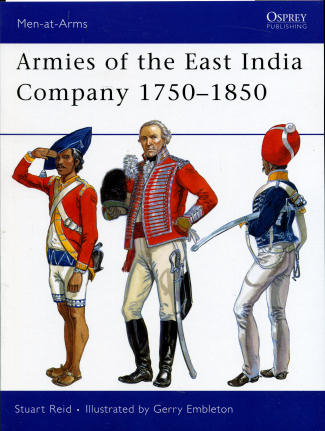 Probably
the world's first multi-national mega-corporation was the British East India
Company. There was little that this company was not involved with during the
18th and 19th century. Such was the size of the organization and so far flung
was it that it was deemed necessary to form their own protection against the
usual banditry and often the armies of smaller nations. The greatest
concentration of these forces was in India where they had major operations in
Madras, Bombay and Bengal.
Probably
the world's first multi-national mega-corporation was the British East India
Company. There was little that this company was not involved with during the
18th and 19th century. Such was the size of the organization and so far flung
was it that it was deemed necessary to form their own protection against the
usual banditry and often the armies of smaller nations. The greatest
concentration of these forces was in India where they had major operations in
Madras, Bombay and Bengal.
Initially, most of the troops for these armies were locals as
were the majority of officers. It was difficult to get Europeans to operate in
these armies as life in the British Army proper offered better pay and
advancement was solely dependent on time in service rather than merit.
Eventually, things changed to where it was required that the officer corps was
British, and conditions became quite different for local troops. This caused a
considerable amount of displeasure amongst the Indian soldiers, especially when
the British started mixing in Indians from various castes and religions. Always
insensitive to the needs of others, this eventually led to the Mutiny of 1858
and the eventual transfer of all East India forces into the control of the
British Army.
The book starts with the early years and the initial build-up
of armies in Madras, Bengal and Bombay. It covers the expansion of these units
and the Cornwallis reorganization plan of 1780 as well as the Mutiny of the
1850s. There are also sections on the European Infantry and on the Native
infantry units as well as Cavalry and Artillery units.
As this series is generally about uniforms and equipment, throughout the book the author and illustrator have shown these
items as used by the soldiers of the various units. They are quite colorful and
in keeping with what you'd expect of Napoleonic era uniforms. Of course, they
have been adapted to the climate and somewhat to the culture of the soldiers.
Thanks to the excellent choice of period
illustrations and those done specifically for the book, we get an idea of how these men were dressed and
outfitted. This all makes yet another great addition to the superb library of
Osprey titles and one you can purchase with confidence.
October 2009
For more on the complete line of Osprey books,
visit www.ospreypublishing.com. In the US, it is
Osprey Direct at 44-02 23rd St, Suite 219, Long Island City, NY 11101., where you can
get a catalogue of available books.
If you would like your product reviewed fairly and quickly by a
site that has nearly 350,000 visitors a month, please contact
me or see other details in the Note to
Contributors.
 Probably
the world's first multi-national mega-corporation was the British East India
Company. There was little that this company was not involved with during the
18th and 19th century. Such was the size of the organization and so far flung
was it that it was deemed necessary to form their own protection against the
usual banditry and often the armies of smaller nations. The greatest
concentration of these forces was in India where they had major operations in
Madras, Bombay and Bengal.
Probably
the world's first multi-national mega-corporation was the British East India
Company. There was little that this company was not involved with during the
18th and 19th century. Such was the size of the organization and so far flung
was it that it was deemed necessary to form their own protection against the
usual banditry and often the armies of smaller nations. The greatest
concentration of these forces was in India where they had major operations in
Madras, Bombay and Bengal.